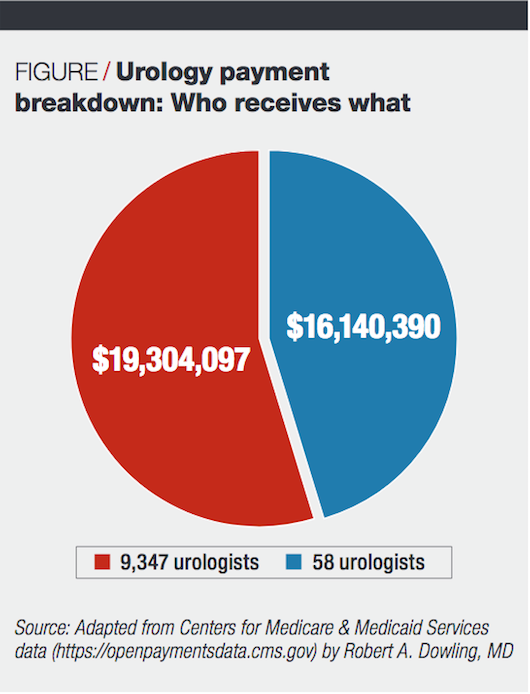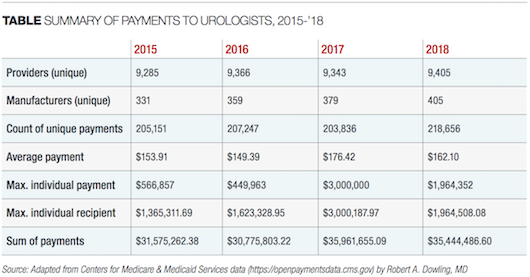Article
Open Payments data: What you should know about 2019 update
Author(s):
The average industry payment to a urologist saw a decline in 2018 compared with the previous year.

The average industry payment to a urologist saw a decline in 2018 compared with the previous year.
That’s according to the Centers for Medicare & Medicaid Services’ (CMS) annual update of Open Payments Financial Data (calendar year 2018) (https://openpaymentsdata.cms.gov/). Section 6002 of the Affordable Care Act, also known as the Physician Payments Sunshine Act, requires that manufacturers of “covered drugs, devices, biologicals, and medical supplies” report payments and other transfers of value to physicians to CMS. It also requires that manufacturers and group purchasing organizations report physician (or their family) ownership and investment interests. In this article, I review some summary information and analysis about urology as it pertains to Open Payments data.
Also by Dr. Dowling: HHS program collects data on malpractice, adverse actions
In 2018, $9.35 billion in payments or investment value was reported by 1,582 unique companies to physicians, teaching hospitals, and other entities; this is an increase of 3.7% in payments compared to the 2017 total. The total amount of general payments to individual physician recipients was $2.17 billion. According to the data, 9,405 urologists received a total of $35,444,486.60 in general payments to physicians, or 1.63% of the total general payments.

The largest single payment to a urologist was $1,964,352 for a royalty/license, and the average payment to a urologist in 2018 was $162.10 (down from 2017). In addition, 58 urologists each received more than $100,000 and collectively represented more than 45% of all payments to urologists (table, figure). As in past years, most of the payments to urologists came in the form of cash and were compensation for services other than consulting, consulting fees, food and beverage, and royalty or license.
Next: Drug/biologic-related payments increaseDrug/biologic-related payments increase
CMS requires manufacturers to associate a payment with a drug, biologic, device, or medical supply where appropriate. General payments to urologists associated with devices comprised the largest collective payments, totaling $18,430,482, or more than half of all general payments. Payments associated with drugs and biologics totaled almost $13.7 million, significantly more than in 2017; three drug manufacturers accounted for almost 50% of total payments in this category.
Read: Twelve Part D urology meds top $100 million in spending
The database also associates payments with a product category or therapeutic area; payments to urologists came largely from manufacturers who classified their product as urology, oncology, or male health related. Eight single products (one device and seven drugs) accounted for more than 50% of payments in 2018.

Bottom line: General payments from manufacturers to urologists in 2018 reported to and by CMS under the Sunshine Act represent a tiny fraction of general payments to physicians and average less than $200.
In keeping with past years, most of these payments are from device manufacturers, and payments are concentrated in a handful of individual companies, drugs, devices, recipients, and disease states. Prostate cancer (drugs), BPH (devices), and overactive bladder (drugs) continue to represent most of the collective spending in the specialty. Although the vast majority of urologists appear in the data, but payments are generally so insignificant that most need not worry about the appearance of impropriety.

















